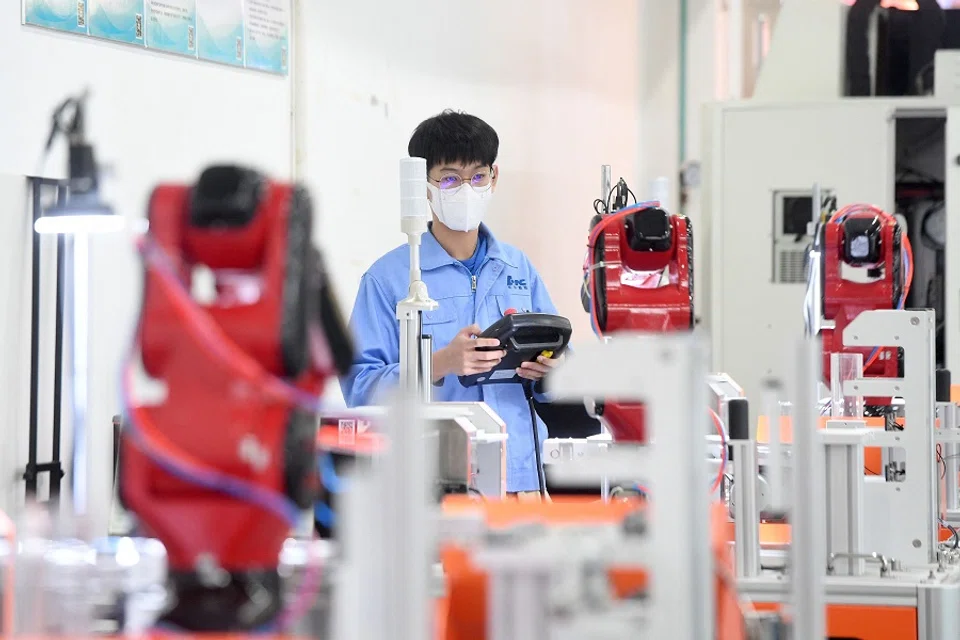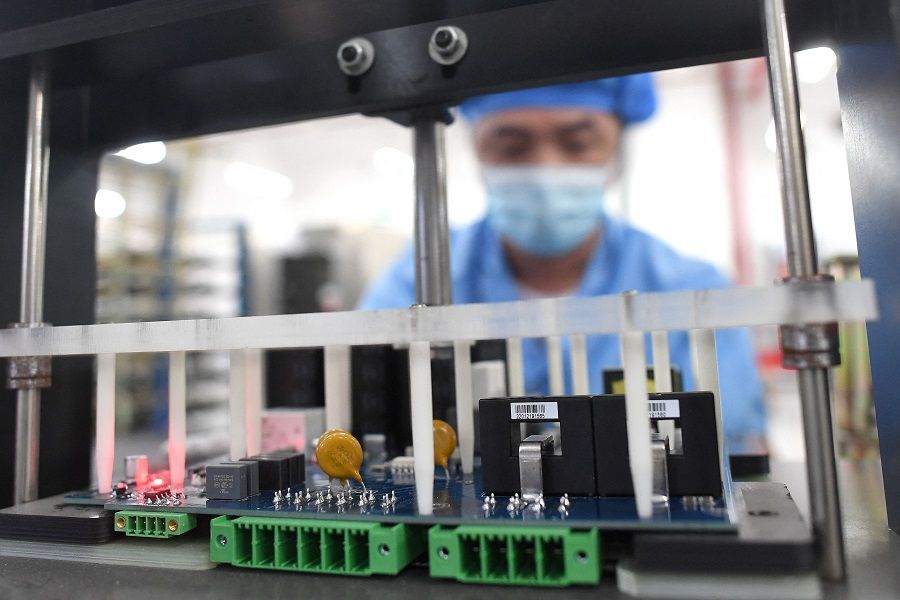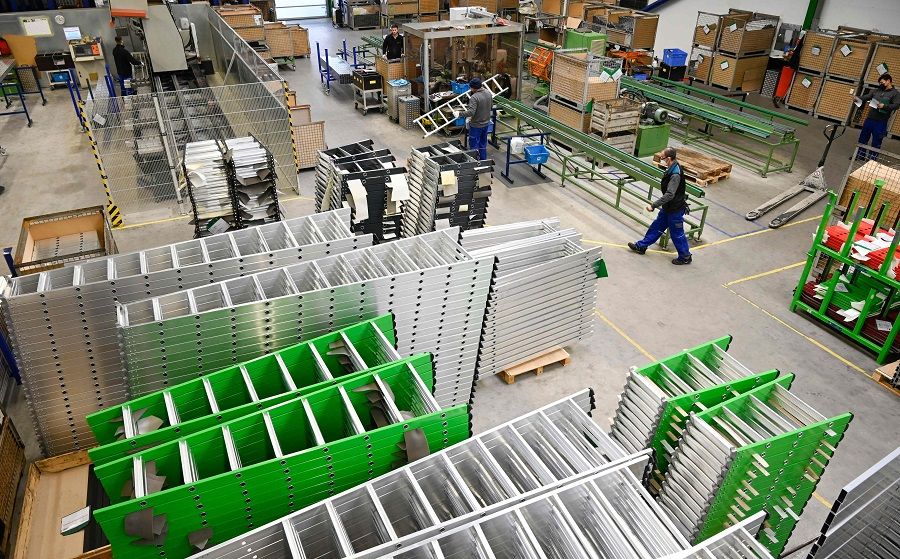Why China has too many graduates and not enough skilled workers

These days, students from secondary and tertiary vocational schools are snapped up by various enterprises even before they graduate, according to a CCTV Caijing (央视财经) report that has attracted widespread attention.
Sun Zhijuan, director of Shenzhen Institute of Technology's laser department, tells Caixin that all the graduands at her school already have around two to four job offers. As a result, enterprises that have set up recruitment drives at their school often leave dissatisfied or even empty-handed. Many enterprises thus come to the institution half a year or even one to two years in advance in search of talents.
Compared with the rather bleak employment situation as a result of the Covid-19 pandemic, economic downturn and structural adjustments, students from vocational schools seem to have no problems in securing a job, posing an intriguing phenomenon.
... the manufacturing sector had the highest shortage of workers - 17 out of the 24 newly added occupations on the list were related to this sector.
East Asia's backward education concept and system
It is common knowledge that China is a manufacturing giant on its way to becoming a global manufacturing power and is in urgent need of highly skilled talents. China's Ministry of Human Resources and Social Security previously released a list of the top 100 occupations in China that saw more vacancies than applicants in the third quarter of 2021.
Of the listed occupations, the manufacturing sector had the highest shortage of workers - 17 out of the 24 newly added occupations on the list were related to this sector.
Based on the latest statistics, the total number of skilled workers in the ten key areas of China's manufacturing industry will reach approximately 62 million by 2025, with a talent demand gap of nearly 30 million. Given this backdrop, skilled workers with relevant experience will naturally be highly sought after, further pushing up their salary levels.
Meanwhile, the total number of graduates in China continues to hit record highs every year. According to statistics from the Ministry of Education, China saw a record 9.09 million new graduates from the country's universities in 2021, an increase of 350,000 graduates compared with 2020 and crossing the nine million mark.
Also, over 800,000 Chinese students who recently graduated from universities abroad also returned to China, joining the army of jobseekers.
Faced with the grim and complex employment situation amid the pandemic, the Chinese Ministry of Education and other related ministries are not only striving to expand market jobs but also institutionalising job quotas to stabilise the employment situation of college graduates.
... education is aimed at gaining merit to enter the country's elite class.

The main dilemma of China's labour market has in turn become the dilemma between the increasing demand for skilled professionals in the growing manufacturing industry and the backward education concept and system.
Based on traditional Chinese thought, the real purpose of education is not to gain knowledge. In particular, with the formation of the imperial examination system following the Tang and Song dynasties, education is aimed at gaining merit to enter the country's elite class. The people in ancient China studied to get into the upper class. As the Chinese saying goes, "Even a commoner can strive to become an official" (朝为田舍郎,暮登天子堂).
Thus, China's "graduate school fever", "civil servant fever" and even the rush to obtain a doctoral degree are all seen as bringing honour to the family. While this is indeed an important manifestation of East Asian society's focus on education, we have to realise that this phenomenon is actually driven by remnants of the backward ideology of the ancient feudal society and is not attuned to the market and the modern industrial and commercial society.
... [Shuji Nakamura] believes that the Asian educational system is "a waste of time" and that young people should be able to study different things.
Shuji Nakamura, who was awarded the 2014 Nobel Prize in Physics for inventing blue LEDs, once criticised Japan's patent system and the entire East Asian education system. He said, "The Japanese entrance exam system is very bad. And China, Japan [and] South Korea are all the same. For all high school students, their education target is to enter a famous university." He believes that the Asian educational system is "a waste of time" and that young people should be able to study different things.
In fact, Japan's education system is already the most lenient among China, Japan and South Korea, which are known for their extreme testing pressure.

The three most prestigious universities in South Korea are Seoul National University, Korea University and Yonsei University, which form the acronym "SKY". Out of the top CEOs at the largest enterprises in South Korea, 70% graduated from one of the three universities, along with 80% of South Korea's judiciary personnel and civil servants.
Almost all South Korean children attend tuition classes with the aim of entering one of the three universities and becoming the elites of South Korean society. Huge education expenses are also one of the main reasons South Koreans do not want to have more children. This situation with South Korean education is the epitome of East Asian society.
Modern education system driven by Industrial Revolution
The modern education system originated in 18th century Prussia. Prior to the 19th century, education mostly resembled a craft apprenticeship or a small academic community like that of Confucius and Plato.
However, the demand for relevant knowledge and a workforce that received basic education following the Industrial Revolution gave rise to a schooling system similar to the one in place today.
Eighteenth-century Prussians were the first to implement today's classroom model that allowed tens of thousands of people to become middle class. It provided an important impetus and foundation for Germany to become an industrial powerhouse, and produced a large number of German citizens who are loyal and easy to manage, leading to Germany's comprehensive rise.
In the first half of the 19th century, the US adopted the Prussian education model, which also became a model for European countries, and was later implemented worldwide.
Distortions by East Asian countries
To catch up with Western countries, East Asian countries began adopting the modern education system as well. However, due to deeply entrenched Confucian traditions and the long-standing imperial examination system, the modern system is subconsciously distorted.
... education has a selective function and parents' concept of education is closely related to the social structure and values of the times.

Various adages, epigrams and couplets that inspire students to study hard hang in the classrooms of China's high schools, especially those of final year students.
For example, a couplet writes, "Through years of hard work, sweat and tears, honour shall be yours; through sharpened and refined tools, victory shall be yours" (百炼成钢,磨剑十年,必能展翅酬壮志;秣马厉兵,试锋六月,定当折桂步蟾宫).
I believe that anyone who attended high school in China is no stranger to such scenes and bold words. This phenomenon resulted in the birth of cram schools that are examination experts, such as Hebei's Hengshui High School and Anhui's Maotanchang Middle School, and which numerous local high schools actively emulate.
But we cannot blame these schools or the parents who have high hopes for their children. After all, education has a selective function and parents' concept of education is closely related to the social structure and values of the times.
Germany's current education system not only respects the talent and interests of every child but also takes into consideration Germany's industrial structure and market demand, forming a better match between the child's talent and future career.
Germany's success in vocational education
When we reflect on the problem of such an education system, perhaps we should ask: how did Germany, the founder of this education system, nurture so many highly skilled professionals through its vocational education system and place Germany's manufacturing industry at the forefront of the world? At the same time, since Japan and South Korea are East Asian countries, why do they not face the same shortage of skilled workers as China, another East Asian country?
The answer to the first question can perhaps be found in the fact that Germany's current education system not only respects the talent and interests of every child but also takes into consideration Germany's industrial structure and market demand, forming a better match between the child's talent and future career.
Germany's primary education is a four-year system, with students graduating from primary school at the age of ten. Then, they would either enter a general secondary school, a vocational secondary school, or an academic secondary school based on their results and interests.
Top performers would enter an academic secondary school for eight years of study and receive a qualification upon graduation that would grant them admission into general universities in Germany. Meanwhile, students from the general and vocational secondary schools would most likely pursue vocational qualifications.
At its core, Germany's vocational education is a dual system based on a school-enterprise cooperation mechanism, combining traditional apprenticeship with modern vocational education.

Indeed, Germany's manufacturing industry has been able to lead the world and its enterprises can boast of numerous technical advantages in niche markets because the industry is backed by a massive army of skilled professionals and a talent training system that features vocational education.
At its core, Germany's vocational education is a dual system based on a school-enterprise cooperation mechanism, combining traditional apprenticeship with modern vocational education. In Germany, the characteristic and purpose of vocational education at the high school level is to provide mature, qualified and skilled workers to companies directly.
The cooperation between enterprises and schools is not only reflected in the specific and detailed division of labour in the talent training process, but also in its close coordination with defining talent development standards on the macro level, to jointly come up with relevant vocational training regulations and teaching frameworks.
At the same time, the total cost of talent development is also shared between schools and enterprises, with investments made by German companies even exceeding those made by public finance. Besides, enterprises also have something to gain from their investments - through this process, they are able to hire skilled professionals, which may not be readily available in the market.
This healthy mechanism of cooperation, coordination and competition between industry and education, and between companies and schools, has not only allowed Germany's vocational education to nurture high-quality and skilled workers but has also created a win-win situation for schools, enterprises and the government in the field of vocational education.
This ultimately ensured the competitiveness of Germany's manufacturing sector and consolidated the stable position of Germany's middle class.
Germany's vocational education enjoys great success because first and foremost it established the concept that all professions are equal.

Germany's vocational education enjoys great success because first and foremost it established the concept that all professions are equal. In their value system, they do not believe that "all professions are lowly with the exception of being an official" (万般皆下品,唯有读书高). Hence, they do not believe that there is only one path to success.
In fact, skilled tradesmen in Germany enjoy a higher social status and recognition in German society because they earn a decent income. Some of them could even become employers themselves by upgrading their professional qualifications during the course of their careers, and then gain higher social status and increased income. Also, the high sociocultural recognition that skilled tradesmen in Germany enjoy is also deeply entrenched in German society and culture.
Transforming China's education system
Following decades of continuous development, China's higher education system has made brilliant achievements. As of 2019, China's gross enrolment ratio in higher education reached 51.6%, with 40.02 million students studying in universities and institutions, forming the world's largest higher education system.
At the same time, China's higher education system is also heavily influenced by the Soviet Union, with its talent development model bearing distinctive characteristics of a planned economy.
... the influence of the Soviet educational model is still deeply entrenched in the deepest levels of talent development and teaching.
In the 1950s, the Chinese higher education underwent a profound and comprehensive reform under the guidance of Soviet experts. Following the large-scale restructuring of faculties in 1952, China's higher education system is organised by ministries and commissions that directly correspond to the needs of the country's economic development.
It can be said that the Soviet education model laid the foundation for the basic structure of contemporary Chinese higher education - today's basic teaching and management system in the universities is still a product of the 1950s.
Following reform and opening up, while the organisational structure and talent development model of Chinese universities are constantly reformed, the influence of the Soviet educational model is still deeply entrenched in the deepest levels of talent development and teaching.

While this system certainly played a positive role in providing various industries with a large number of much-needed talents throughout history, in today's era where China has shifted to a market economy and the market plays a decisive role in resource allocation, this highly centralised and planned education system and the overly specialised teaching system is drifting away from the needs of society and the economy.
Especially against the backdrop of China's current emphasis on social transformation, industrial upgrading and becoming a global manufacturing power, it is necessary to optimise the supply side of China's higher education system, in particular vocational education.
The transformation and upgrading of China's manufacturing industry calls for more skilled talents, and the market outlook will force the backward education concept and system to continuously adapt to such growing demand.
Notably, the higher-ups are already aware of the problems with China's vocational education. In October 2021, the general offices of the Communist Party of China Central Committee and the State Council jointly issued a set of guidelines on promoting the high-quality development of modern vocational education (《关于推动现代职业教育高质量发展的意见》), where the optimisation of the supply side of vocational education was proposed.
The guidelines also detailed four tasks: one, development of new careers in the manufacturing sector; two, development of scarce skills jobs that support the government's projects to improve people's livelihoods; three, making timely adjustments to traditional jobs required for the transformation and upgrading of the economy; and four, encouraging schools to open more courses for scarce skills jobs that meet market demand, thereby forming a career system that is closely aligned with the industrial and innovation chains. This series of reforms set a clear direction for strengthening the adaptability of vocational education.
Over a decade ago, renowned economist Professor Zhang Wuchang was invited to tour a factory in the inland region. He witnessed the same robotic movements of the workers on the assembly line and how they would even have to run to go to the toilet, since time is measured by the minute in this factory. He lamented, "If all the children of our Chinese nation work in this manner, how could they accumulate human capital and how is innovation possible?"
Over the course of China's economic development, the manufacturing era that relied on cheap labour is over. As the demographic dividend disappears, the new generation of youths and their parents are now two completely different generations. The transformation and upgrading of China's manufacturing industry calls for more skilled talents, and the market outlook will force the backward education concept and system to continuously adapt to such growing demand.
This article was first published in Chinese by Caixin Global as "高级技工的短缺时代". Caixin Global is one of the most respected sources for macroeconomic, financial and business news and information about China.
Related: Plight of China's new generation of young migrant workers highlights pitfalls of labour reforms | A burning issue among Chinese youths: How to escape the rat race? | Are China's youths leaving the internet sector for the public sector? | 200 million Chinese are in flexible employment. Is this their choice? | Are the Chinese embracing the 'iron rice bowl' again? | Record 10.76 million Chinese university graduates face bleak job market and struggling economy

